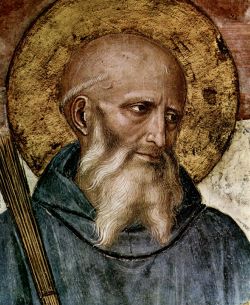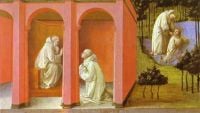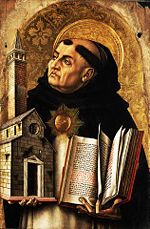Benedict of Nursia
| Saint Benedict | |
|---|---|
Detail from fresco by Fra Angelico | |
| Abbot Patron of Europe | |
| Born | c. 480 in Norcia (Umbria, Italy) |
| Died | c. 547 in Monte Cassino |
| Venerated in | Roman Catholic Church Anglican Communion Eastern Orthodox Church Lutheran Church |
| Canonized | 1220 |
| Major shrine | Monte Cassino Abbey;
Saint-Benoît-sur-Loire, near Orléans, France; Sacro Speco, at Subiaco, Italy |
| Feast | Western Christianity: 11 July (in pre-1969 calendars, 21 March) Byzantine Rite: 14 March |
| Attributes | -Bell, broken cup with serpent representing poison, bush, crosier, Benedictine cowl, copy of his Rule, rod of discipline, raven |
| Patronage | -Against poison, against witchcraft, of agricultural workers, civil engineers,coppersmiths, dying people, Europe, farmers, fever, various other disease, Italian architects, Norcia (Italy, people in religious orders,Schoolchildren, servants who have broken their master's belongings, spelunkers, against temptations. |
Saint Benedict of Nursia(c. 480 - c. 547) was a saint from Italy, the founder of Western Christian monastic communities, and an important rule-giver for cenobitic monks. He was canonized by the Roman Catholic Church in 1220.
Benedict founded 12 communities for monks, the best known of which is his first monastery, at Monte Cassino in the mountains of southern Italy. However, he did found a distinct religious order. His purpose, as stated in his Rule, was that "Christ... may bring us all together to life eternal."
Benedict's main achievement is his "Rule," containing precepts for his monks. It is heavily influenced by the writings of John Cassian, and shows strong affinity with the Rule of the Master. Its unique spirit of balance, moderation, and reasonableness, however, persuaded most European religious communities founded throughout the Middle Ages to adopt it. As a result, the Rule of St Benedict became one of the most influential religious monastic rules in Christendom.
Because of the immense influence of his Rule, Benedict is often called the founder of western Christian monasticism. The Order of St Benedict itself is of modern origin. It not, strictly speaking, an "order" as commonly understood but a confederation of autonomous congregations under the Benedictine Rule.
Biography
The only authentic ancient account of Benedict is found in the second volume of Pope Gregory I's four-book Dialogues, written in 593. Gregory’s account of this saint’s life is not, however, a biography in the modern sense of the word. It provides instead a spiritual portrait of the gentle, disciplined abbot. It consists, for the most part, of a number of miraculous incidents give little help towards a chronological account of his career. Gregory's primary authorities for his account were Honoratus, abbot of the monastery at Subiaco when Gregory wrote, and Constantinus, Benedict's disciple and successor as abbot of Monte Cassino.
Early life
Benedict was the son of a Roman noble of Nursia, the modern Norcia, in Umbria, central Italy. A tradition related by the English writer Bede says the Benedict a twin, with his sister being a woman named Scholastica. His boyhood was spent in Rome, where he lived with his parents and attended the schools until he had reached his higher studies. Then, according the Gregory's account, "giving over his books, and forsaking his father's house and wealth, with a mind only to serve God, he sought for some place where he might attain to the desire of his holy purpose; and in this sort he departed [from Rome], instructed with learned ignorance and furnished with unlearned wisdom." His exact age at the time is a matter of debate, generally presumed to be between the ages 14 and 20.
Benedict does not seem to have left Rome for the purpose of becoming a hermit, but only to find some place away from the life of the great city. He took his old nurse with him as a servant and they settled down to live in Enfide, near a church dedicated to St Peter, in some kind of association with "a company of virtuous men" who were in sympathy with his spiritual feelings and his views of life. Enfide, which the tradition of the monastery at Subiaco identifies with the modern Affile, is in the Simbruini mountains, about 40 miles from Rome and two from Subiaco.
A short distance from Enfide is the entrance to a narrow, gloomy valley, penetrating the mountains. The ravine soon reaches the site of a former villa of the emperor Nero. Nearby were the ruins of certain Roman baths, of which a few great arches and detached masses of wall still stand. A nearby cave about ten feet deep with a large triangular-shaped opening is traditionally believed to have served as Benedict's cell. Below, after a rapid descent lay the blue waters of a lake.
On his way from Enfide, Benedict met a monk, Romanus of Subiaco, whose monastery was on the mountain above the cliff overhanging the cave. Romanus had discussed with Benedict the purpose which had brought him to Subiaco, and had given him the monk's habit. By his advice Benedict became a hermit and for three years. During this time he lived virtually unknown to men, in his cave above the lake.
During this time he was visited Romanus, who brought him food.
Later life
Through his time as a hermit, Benedict matured both in mind and character. His life of discipline and solitude also one him the respect of local Christians. On the death of the abbot of a monastery in the neighborhood, identified by some with Vicovaro, the community came to him and invited him to become its abbot. Benedict was acquainted with the life and discipline of the monastery, and knew that "their manners were diverse from his and therefore that they would never agree together." However, he finally acceded to their wishes.
The experiment failed badly, however, so much so that the monks tried to poison him, and he returned to his cave. The legend goes that they first tried to poison his drink. However, when he prayed a blessing over the cup, it miraculously shattered. Then they tried to poison his bread. This time, when he blessed the bread, a raven swept in and took the loaf away. From this time on his miracles are said to have become increasingly frequent. Many people, attracted by his sanctity and character, came to Subiaco to be seek his guidance and learn the true way of monastic life.
For these pilgrims he caused 12 additional monasteries to be constructed in the valley, in each of which he placed a superior with 12 monks. In a thirteenth he himself lived with "a few, such as he thought would more profit and be better instructed by his own presence." He remained the abbot of all 13 cloisters. In association with the monasteries began several schools for children. Among the first to be raised under his care were the future saints Maurus and Placidus.
Benedict spent the rest of his life realizing the ideal of monasticism. To create unity and formalize discipline, he drew up his famous Rule. He died at Monte Cassino, Italy on March 21, 547.
The Benedictine Rule
A work of 73 short chapters it presents both spiritual guidance concerning how to live a life on earth centered on Christ and administrative guidelines on how to run a monastery efficiently. More than half the chapters describe how to be obedient and humble, and what to do when a member of the community is not. About one-fourth regulate the worship of God . One-tenth outline how, and by whom, the monastery should be managed. And another tenth specifically describe the abbot’s pastoral duties.
Legacy
Benedict became extremely influential as his Rule came to be adopted in many monasteries of Western Christendom.
The Saint Benedict Medal
This medal originally came from a cross in honor of St Benedict. On one side, the St Benedict medal has an image of Benedict, holding the Holy Rule in his left hand and a cross in his right. There is a raven on one side of him, with a cup on the other side of him. Around the medal's outer margin is "Eius in obitu nostro praesentia muniamur" ("May we, at our death, be fortified by His presence"). The other side of the medal has a cross with the initials for the words "Crux Sacra Sit Mihi Lux" ("May the Holy Cross be my light") on the vertical beam and the initials for "Non Draco Sit Mihi Dux" ("Let not the dragon be my guide") on the horizontal beam. The initial letters for "Crux Sancti Patris Benedicti" ("The Cross of Our Holy Father Benedict") are on the interior angles of the cross. Around the medal's margin on this side are the initials for "Vade Retro Satana, Nunquam Suade Mihi Vana—Sunt Mala Quae Libas, Ipse Venena Bibas" ("Begone, Satan, do not suggest to me thy vanities—evil are the things thou profferest, drink thou thy own poison"). Either the inscription "Pax" (Peace) or the Christogram "IHS" is located at the top of the cross in most cases.
This medal was first struck in 1880 to commemorate the fourteenth centenary of St Benedict's birth and is also called the Jubilee Medal; its exact origin, however, is unknown. In 1647, during a witchcraft trial at Natternberg near Metten Abbey in Bavaria, the accused women testified they had no power over Metten, which was under the protection of the cross. An investigation found a number of painted crosses on the walls of the abbey with the letters now found on St Benedict medals, but their meaning had been forgotten. A manuscript written in 1415 was eventually found that had a picture of Saint Benedict holding a scroll in one hand and a staff which ended in a cross in the other. On the scroll and staff were written the full words of the initials contained on the crosses. Medals then began to be struck in Germany, which then spread throughout Europe. This medal was first approved by Pope Benedict XIV in his briefs of December 23, 1741, and March 12, 1742.
Saint Benedict has been also the motive of many collector's coins around the world. One of the most prestigious and recent ones is the Austria 50 euro 'The Christian Religious Orders', issued in March 13, 2002.
Influence
The early middle ages have been called "the Benedictine centuries."[1] In April 2008, Pope Benedict XVI discussed the influence St. Benedict had on Western Europe. The pope said that “with his life and work St. Benedict exercised a fundamental influence on the development of European civilization and culture” and helped Europe to emerge from the "dark night of history" that followed the fall of the Roman empire.[2]
The influence of St. Benedict produced "a true spiritual ferment" in Europe, and over the coming decades his followers spread across the continent to establish a new cultural unity based on Christian faith.
In 1964, Pope Paul VI named St. Benedict as patron saint of Europe.
He was named patron protector of Europe by Pope Paul VI in 1964. His feast day, previously 21 March, was moved in 1969 to 11 July, a date on which, in many areas, he was traditionally celebrated since the eighth century, because otherwise it would every year be impeded by the observance of Lent, during which there are no obligatory Memorials.[3]
See also
- Anthony the Great
- Benedictine Order
- Camaldolese
- Hermit
- Poustinia
Notes
- ↑ Western Europe in the Middle Ages
- ↑ Benedict XVI, "Saint Benedict of Norcia" Homily given to a general audience at St Peter's Square on Wednesday, 9 April 2008, at [1]
- ↑ Calendarium Romanum (Libreria Editrice Vaticana), pp. 97 and 119
ReferencesISBN links support NWE through referral fees
This article incorporates text from the public-domain Catholic Encyclopedia of 1913.
- Gold-colored small Saint Benedict crucifix.jpg
Small gold-colored St Benedict Crucifix
External links
- A Benedictine Oblate Priest - The Rule in Parish Life
- Guide to Saint Benedict
- Sacro speco, Grotta della Preghiera – general view " – enlarged view
- The Holy Rule of St. Benedict - Online translation by Rev. Boniface Verheyen, OSB, of St. Benedict's Abbey
- The Order of Saint Benedict
- The Medal Or Cross of St. Benedict: Its Origin, Meaning, and Privileges
- Life and Miracles of St Benedict
- Works by or about Benedict of Nursia in libraries (WorldCat catalog)
- The Life of St. Benedict: Introduction. Retrieved 2008-11-17.
| |||||||||||||||||||||||||||||||||||||||||||||
| ||||||||||||||||||||||||||||||||||||||||||
| |||||||||||||||||||||||||||||||||||||||||
Credits
New World Encyclopedia writers and editors rewrote and completed the Wikipedia article in accordance with New World Encyclopedia standards. This article abides by terms of the Creative Commons CC-by-sa 3.0 License (CC-by-sa), which may be used and disseminated with proper attribution. Credit is due under the terms of this license that can reference both the New World Encyclopedia contributors and the selfless volunteer contributors of the Wikimedia Foundation. To cite this article click here for a list of acceptable citing formats.The history of earlier contributions by wikipedians is accessible to researchers here:
The history of this article since it was imported to New World Encyclopedia:
Note: Some restrictions may apply to use of individual images which are separately licensed.







